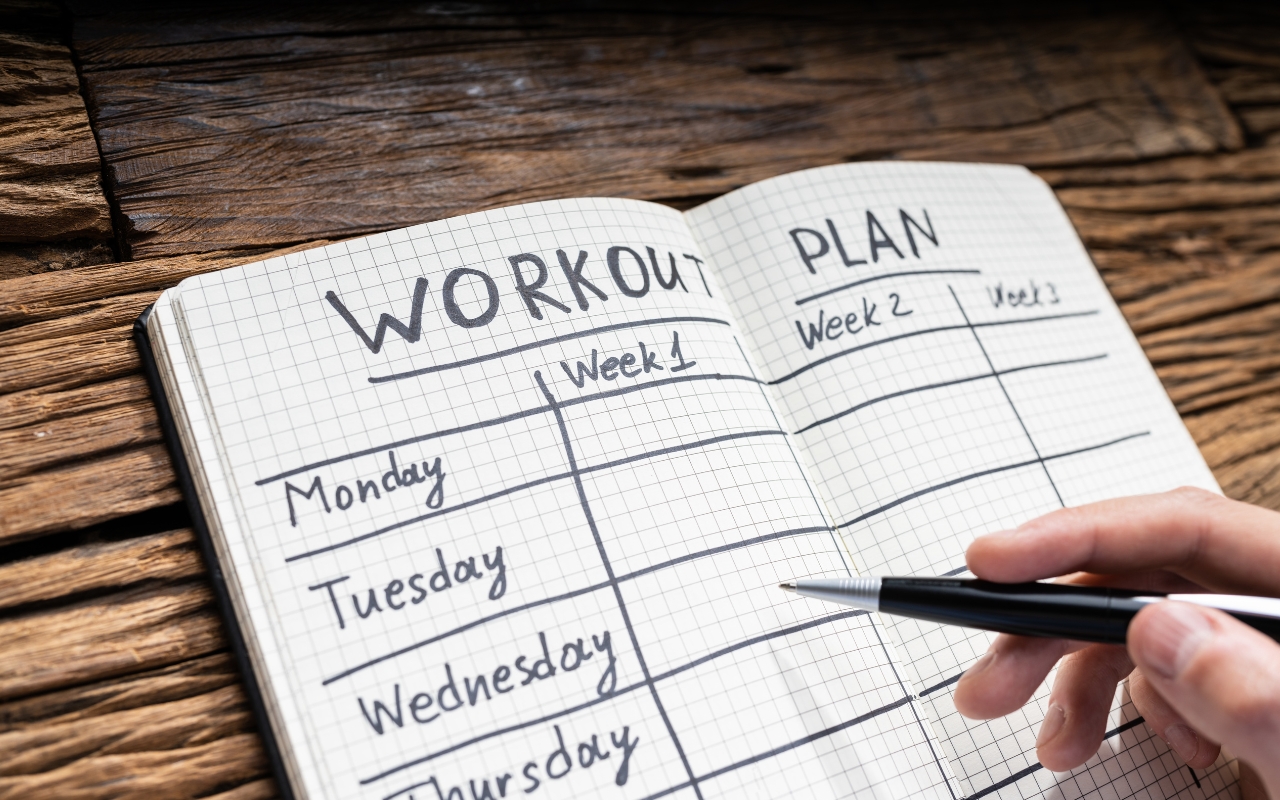Fitness
How do I create a balanced workout plan?
Published
2 years agoon
By
mbkteam
Embarking on a fitness journey can seem daunting, especially if you are starting from scratch or have been away from regular exercise for some time. However, adopting a consistent fitness routine is a transformative endeavor that can enhance your physical health, boost your mental well-being, and significantly improve your quality of life. Understanding the most effective ways to integrate exercise into your daily routine, stay motivated, and overcome common obstacles can pave the way for lifelong fitness. This article aims to provide a comprehensive guide to starting and maintaining an effective exercise regimen, drawing on expert advice and actionable tips.
The Importance of Setting Realistic Goals
When beginning your fitness journey, setting realistic and achievable goals is crucial. Starting with manageable, short-term objectives can provide a sense of accomplishment and motivate you to keep going. For instance, if your initial goal is to run one mile within your first month, you can subsequently aim to run two or three miles in the following months. This approach, focusing on process goals (such as increasing the time spent on a treadmill) rather than outcome goals (like lowering your resting heart rate), is more attainable and can prevent discouragement.
Creating a Structured Fitness Plan
A structured fitness plan is essential for consistency and progress. Begin by identifying the type of exercise you enjoy, as this will increase the likelihood of sticking with the program. Whether it's biking, swimming, hiking, or dancing, choosing enjoyable activities ensures that exercise feels less like a chore and more like a pleasant routine. Experts recommend starting slowly and gradually increasing your workouts' volume and intensity to prevent burnout and injury.
Time management is another vital aspect. Busy schedules often prevent regular exercise. To overcome this, treat your workout sessions as important appointments. Schedule your workouts on your calendar, just like work meetings or social engagements, and honor this time commitment. If you miss a planned session, have a backup plan ready—perhaps a shorter, more flexible workout that you can fit into your day (The New York Times).
Making Exercise Convenient
Convenience plays a pivotal role in the sustainability of a fitness regimen. To reduce excuses and make it easier to stick to your routine, set up your environment for success. Store your fitness equipment in visible, easily accessible places. Whether it’s a yoga mat in your living room or dumbbells by your desk, these subtle reminders can encourage you to stay active throughout the day. For morning workouts, laying out your exercise clothes the night before can save time and hassle when you wake up.
Incorporating Flexibility and Variety
Variety is not only the spice of life but also exercise. Incorporating different types of workouts can keep you engaged and prevent monotony. For instance, one day you might go for a run, the next day a yoga session, followed by some strength training. Mixing up your routine can also ensure that different muscle groups are worked and can help avoid overuse injuries. Virtual fitness platforms, such as the Peloton App, offer a wide range of guided workouts led by expert instructors, which can be a great way to introduce variety.
Flexibility in your exercise plan also means understanding the importance of rest days. Recovery is an essential component of any fitness routine. Scheduling active rest days focused on stretching and foam rolling can help prevent burnout and allow your muscles to repair and grow. Listening to your body and knowing when to dial back can prevent injuries and maintain long-term progress.
The Role of Muscle Memory
One of the encouraging aspects of returning to exercise after a break is the presence of muscle memory. Muscle adaptation can last a considerable time, sometimes even a lifetime, making it easier to regain strength and coordination when you resume your routine. This innate ability of the muscles to “remember” past activities facilitates quicker recovery and progress upon restarting your exercise regimen (Peloton).
Motivational Strategies
Staying motivated is often the most challenging part of maintaining an exercise routine. Here are several strategies to keep you on track:
- Celebrate Small Wins: Recognize and celebrate your progress, no matter how small. Whether lifting a heavier weight, running a longer distance, or simply feeling more energetic, celebrating these milestones can boost your motivation.
- Find a Workout Buddy: Exercising with a friend or joining a fitness group can provide accountability and make workouts more enjoyable. The social aspect of group activities, such as joining a running club or participating in group fitness classes, can add an element of fun and foster lasting habits.
- Track Your Progress: Keeping a fitness journal or using apps to log your workouts and monitor progress can provide tangible proof of your improvements. Fitbod and Fitlist are excellent tools for tracking different types of exercise and suggesting new workouts based on your fitness level and muscle recovery status (The New York Times).
- Reward Yourself: Setting up a reward system can be a powerful motivator. Treat yourself to something enjoyable to meet your fitness goals. This could be a new workout outfit, a massage, or a special outing.
Overcoming Common Obstacles
Despite the best intentions, obstacles can hinder your exercise routine. Identifying and developing strategies to overcome these barriers is crucial for long-term success.
- Time Constraints: One of the most common excuses for not exercising is a lack of time. Scheduling shorter, high-intensity workouts can be just as effective as longer sessions. For instance, a 20-minute interval training session can yield significant benefits. Integrating physical activity into daily tasks, such as taking the stairs, gardening, or doing housework, can keep you active even on the busiest days.
- Lack of Energy: If you often feel too tired to work out, consider adjusting your exercise time. Some people find that morning workouts boost their energy for the rest of the day, while others prefer evening sessions to unwind. Ensuring adequate sleep and a balanced diet can also improve your energy levels.
- Boredom: To counteract boredom, regularly update your workout playlist, change your workout scenery, or try new exercise classes. Virtual fitness platforms offer many classes and can be a great way to keep things interesting.
- Inconsistent Motivation: Regularly reassessing and adjusting your fitness goals can help maintain motivation. Setting short-term and long-term goals provides clear milestones and a sense of direction. Additionally, visualizing the benefits of regular exercise, such as improved health and increased vitality, can reinforce your commitment.
Leveraging Technology and Resources
In today’s digital age, numerous resources can aid your fitness journey. Apps and online programs offer personalized workout plans, track progress, and provide community support. Here are a few to consider:
- Peloton App: This app provides access to various workouts, from cycling and running to strength training and yoga, all led by expert instructors.
- Fitbod: Tailor's workout routines are based on your fitness goals and muscle recovery status, making planning practical sessions easier.
- HealthyWage:offers the unique incentive of betting on your fitness goals, with the potential to win cash prizes for reaching them.
- DietBet: A similar concept to HealthyWage, where you can join or create weight loss challenges and win money based on the percentage of weight lost.
- ClassPass: Allows you to experiment with various fitness classes and studios in your area, perfect for those who enjoy variety.
The Psychological Benefits of Exercise
Beyond the obvious physical benefits, regular exercise profoundly impacts mental health. Engaging in physical activity reduces stress, anxiety, and depression while enhancing mood and cognitive function. Exercise stimulates the release of endorphins, often called the body's natural painkillers and mood elevators. Additionally, the sense of accomplishment from meeting fitness goals can boost self-esteem and confidence.
Long-term Commitment to Fitness
Approaching fitness as a lifelong journey rather than a short-term goal is crucial for sustained benefits. Fitness expert Dr. Gordon emphasizes that enhancing fitness should be seen as a continuous process with the philosophy of perpetual improvement. This mindset shift allows for a more adaptable and sustainable approach to fitness, accommodating life's ups and downs without jeopardizing progress (The New York Times).
Integrating Fitness into Daily Life
Making fitness a part of your daily life requires intentionality and creativity. Here are some tips to seamlessly integrate physical activity into your routine:
- Active Commuting: If possible, walk or bike to work instead of driving. For those who live far from their workplace, consider parking further away or getting off public transportation one stop early to incorporate a walk into your commute.
- Desk Exercises: Incorporate simple exercises, such as stretching or using resistance bands, while at your desk. This can help alleviate the physical strain from prolonged sitting and keep your muscles engaged.
- Family Activities: Involve your family in physical activities. Weekend hikes, bike rides, or even playing in the park can be enjoyable ways to stay active together.
- Short Bursts of Activity: When pressed for time, engage in brief periods of exercise. Squats while brushing your teeth, calf raises while waiting for your coffee, or a quick set of push-ups during TV commercials can accumulate significant daily activity.
Conclusion
Starting and maintaining a fitness routine is a journey that requires planning, commitment, and flexibility. You can develop a sustainable and enjoyable exercise habit by setting realistic goals, creating a supportive environment, and using available resources. Remember, the key is to start slow, stay consistent, and be kind to yourself along the way. Celebrate your progress, overcome obstacles with creativity, and maintain a long-term perspective on fitness. Your body and mind will thank you for the positive changes, and you'll find that the benefits extend far beyond physical health, enriching every aspect of your life.













